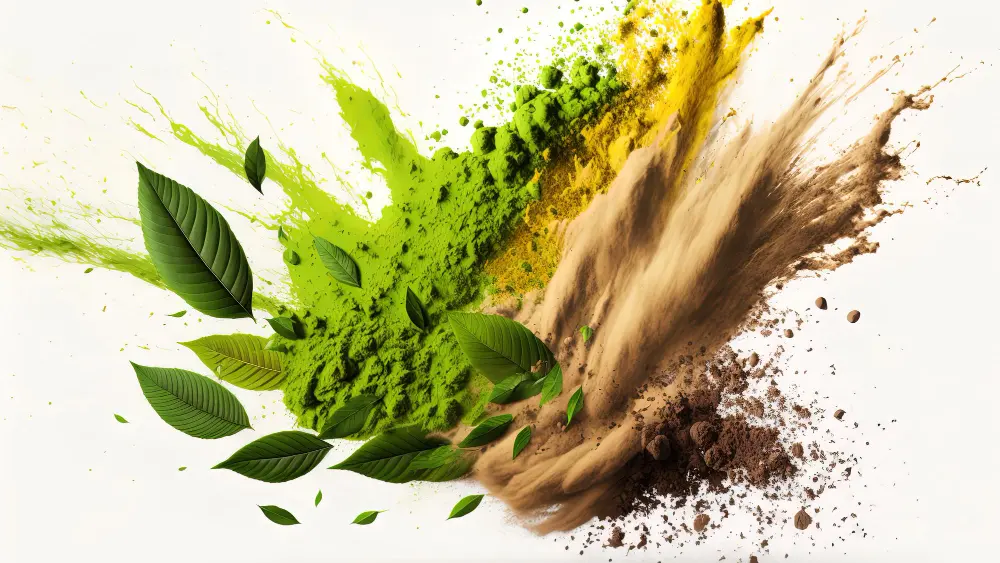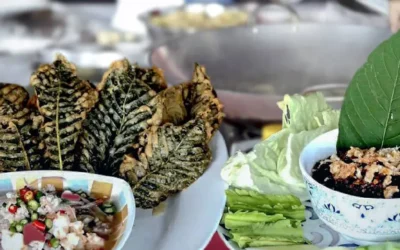Kratom what is it?
Many consumers want to know what kratom is? In this blog we will talk about the diferences of kratom strains, how kratom is used and colors and how the differences make kratom unique.
Kratom, scientifically known as Mitragyna speciosa, is a tropical evergreen tree native to Southeast Asia, particularly found in Thailand, Malaysia, Indonesia, and Papua New Guinea. It belongs to the coffee family (Rubiaceae) and has been used for centuries in traditional medicine by the indigenous populations of these regions.
The leaves of the kratom tree contain compounds called alkaloids, with mitragynine and 7-hydroxymitragynine being the most prominent. Coffee contains Alklaoids such as Caffiene. These alkaloids interact with the brain’s opioid receptors but do so in a way that is distinctively different from traditional opioids like morphine or heroin.
This interaction can produce both energizing and relaxing effects, which vary depending on the dosage and the specific strain of kratom used. Kratom trees can grow up to 80 feet tall similar to Oak or Pine trees in the United States.
People often ask the question What is Kratom? We will answer these questions in the following blog post.
What is Kratom For?
Mitragyna speciosa, more commonly known as kratom, is a tropical tree indigenous to Southeast Asia. It is renowned for its unique composition of alkaloids, the most notable being mitragynine and speciociliatine, among many others. These alkaloids are responsible for kratom’s diverse effects, which can range from stimulating to sedative depending on the strain, dosage, and individual user.
Kratom strains are generally categorized by the color of the veins in the leaves from which they are harvested: red, green, and white being the most common.
Each vein color is associated with a specific set of effects and benefits:
- Red Vein Kratom is known for its calming effects, offering relief and relaxation. It’s often used in the evening or before bed to aid with sleep.
- White Vein Kratom is favored for its ability to enhance alertness, concentration, and overall energy levels, making it popular among users seeking a natural stimulant to kickstart their day or to power through demanding tasks.
- Green Vein Kratom strikes a balance between the sedative qualities of red vein and the stimulating effects of white vein. It’s praised for its ability to enhance focus and provide a mild energy boost while also offering relief.
The presence of numerous alkaloids in kratom contributes to its complex pharmacology, allowing it to have such varied effects on different people. As research into Mitragyna speciosa continues, the understanding of these alkaloids and their potential benefits may expand, offering further insights into how kratom could be used for therapeutic purposes.
In 1836, kratom, scientifically known as Mitragyna speciosa, was reportedly recognized as a viable alternative for various applications in both Malaysia and Thailand. During this period, kratom began to gain acknowledgment for its diverse uses, including its potential as an herbal remedy and its role in traditional medicinal practices in these regions. The plant’s leaves, known for containing psychoactive alkaloids such as mitragynine and 7-hydroxymitragynine, were utilized by local populations for their stimulant and sedative properties.
This early recognition of kratom’s benefits marked the beginning of its historical use in Southeast Asia, setting the stage for its eventual global dissemination and the complex discourse surrounding its use, legality, and research in the centuries to follow.
What is kratom used for?
Supporters of speciosa tea claim that it may have certain benefits. However, it is crucial to note that there is limited scientific research on kratom. Additionally, there is ongoing debate regarding its safety and effectiveness, but what is kratom used for?
Here are some commonly reported benefits associated with kratom tea:
- Relaxation: Kratom has been traditionally used in Southeast Asia for its relaxing properties.
- Mood Enhancement: Some individuals report experiencing improved mood and increased sociability after consuming kratom tea.
- Relief: Kratom tea may have relaxing effects, which can be useful for those seeking daily relief or to unwind.
- Increased Energy: In lower doses, kratom may have energizing effects, potentially providing a boost in energy and focus.
- Herbal Alternative: For those seeking natural alternatives, speciosa tea is often explored as a potential option.
To truly grasp the effects of Mitragyna Speciosa on our bodies, it’s essential to collect and analyze data. The expansion of scientific research will enhance our understanding of this cherished plant.
Often, I’m questioned about whether speciosa is akin to kava or kanna. It’s important to note that it stands distinct in its properties and effects.
Historically, Southeast Asia has utilized Mitragyna Speciosa for centuries as a natural remedy and part of traditional practices. This plant serves as a valuable natural resource for our benefit.
The quest for plants and herbs with potential health benefits is ongoing, with many possibly still undiscovered. It’s time to deepen our exploration into the natural world!
Every entity on Earth serves a purpose, and it’s our job to uncover the beneficial uses of herbs and plants.
Traditionally, Mitragyna Speciosa leaves are plucked and directly chewed or brewed into tea. In contrast, in the USA, we often consume it as a tea powder made from dried leaves, reflecting a variation from its traditional use.
How is kratom used traditionally?
People in Southeast Asia traditionally use Mitragyna Speciosa for different purposes. It grows naturally in countries like Thailand, Indonesia, Malaysia, and Papua New Guinea. The indigenous communities have a long history of using it for its medicinal, cultural, and social significance.
The traditional use of kratom involves:
- Chewing the Leaves: In its native regions, fresh leaves are commonly chewed by workers or laborers to increase energy and reduce fatigue, especially for those engaged in physically demanding tasks. The leaves are often picked fresh from the tree, chewed, and the juices swallowed.
- Brewing Kratom Tea: Preparing tea is another traditional method of consumption. The leaves are dried and then brewed in hot water to extract the alkaloids. The resulting tea is then consumed, and the effects are believed to be more subtle and longer-lasting compared to chewing.
- Medicinal Uses: Traditional herbal uses, kratom has been used to manage various issues.
- Cultural and Social Use: Kratom is sometimes used in religious or cultural ceremonies in certain Southeast Asian communities. Additionally, it has been used as a social beverage during gatherings and celebrations.
- Energizing Effect: In lower doses, kratom has been used for its energizing properties, providing increased energy and focus.
- Relief: Kratom has been traditionally used as a natural reliever, and it’s especially popular among manual laborers and workers who engage in physically strenuous activities.
It’s important to note that the traditional use in its native regions may differ from how it is used in other parts of the world, where it has gained popularity more recently as an herbal supplement. Like any substance, traditional or not, speciosa use has potential risks. Its safety and effectiveness are still being researched and debated.
Traditionally, leaves were discarded after the active alkaloids were extracted from the leaves through the simmering process. There is not a right or wrong way to use it comparatively, but traditional use does not include ingesting the plant material as we do here in the United States.
Kratom capsules can be made at home by using tea powder from Christopher’s Organic Botanicals. Empty Capsules and small capsule machines are inexpensive to make capsules at home. I purchase mine at Capsule Connection. They have been in business since 1973 and have great products and selection.
Most people have never heard of Mitragyna Speciosa and if they do hear about this wonderful plant from google it is usually negative. When people hear about effects for the first time there is usually a google reference to why it isn’t a good choice. We must research these plants ourselves to see if it is something that we should use.
Can you smoke kratom?
A quick answer is No! While it is technically possible to smoke kratom, it is not an efficient or recommended method of consumption. Smoking kratom is not as effective or as safe as brewing tea or taking it orally to experience its effects.
Here are some reasons why smoking kratom is not a practical or advisable approach:
- Low Efficacy: The active compounds in kratom, particularly mitragynine and 7-hydroxymitragynine, are not well-suited for absorption through the lungs. Smoking kratom has less effect than other ways of taking it, so the impact may be minimal.
- Harsh Smoke: Kratom leaves and powder are not designed to be smoked, and burning them can produce a harsh and unpleasant smoke that may irritate the respiratory system.
- Wasteful: Smoking kratom can be wasteful since a significant amount of the active compounds may be destroyed by the heat during the burning process.
- Safety Concerns: Smoking any substance, including kratom, poses potential health risks to the lungs and respiratory system. There is also a lack of scientific research on the long-term effects of smoking kratom.
- Alternative Methods: Kratom can be consumed more effectively through other methods such as brewing kratom tea, ingesting it as capsules, or taking it as a powder mixed with a beverage.
Learn more about kratom
Learn more about kratom by visiting the National Institute on Drug Abuse, or by visiting Kratom Answers. Check out our 3 year old kratom tree from Southeast Asia and take a look at the leaves for yourself! At 3 years old this tree has great alkaloid content. We focus on Fair trade practices that support economic stability in the supply chain.
There is a great video from Hamilton’s Pharmacopia that shows how Thailand kratom farmers had to secretly grow kratom for decades because of the kratom ban in Thailand.
Bottom Line
- We care about Kratom, and We care about You!
- God Bless You and Thank You for being here with us!
- I LOVE KRATOM!
Christopher:)



0 Comments